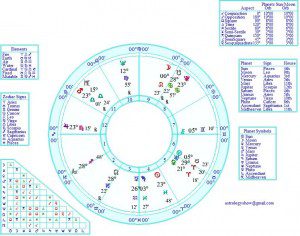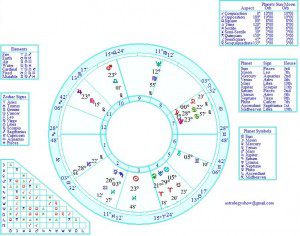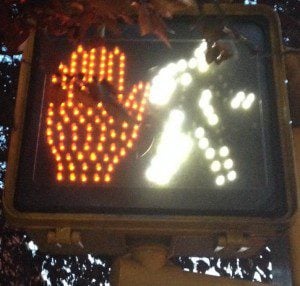Lots of people have an interest in astrology, but not many people can actually read a birth chart. It’s one thing to read a breakdown of someone’s chart that tells you what the placements are and what they mean, but it’s quite another to actually just look at a birth chart and absorb what it’s telling you. Asking someone for driving directions to the nearest Dairy Queen is one thing, but knowing the address of the Dairy Queen and decoding how to get there from a road map is an entirely different mental skill set.
I’m currently teaching an online astrology course and here is one of the charts I will be using, so you can play along at home. Once you get the hang of it, it’s actually pretty easy.
First: here’s how I would list the components of Fred’s chart if I were writing a blog entry about it (No, this person’s name isn’t actually Fred. The identity of who this is will not be revealed until the end of the class. Don’t go trying to figure out who it is. Just go with it, okay?
Sun in Pisces, Moon in Leo, Sagittarius Rising
Mercury in Aquarius, Venus in Aries, Mars in Libra
Jupiter in Scorpio, Saturn in Pisces
Uranus in Aries, Neptune in Virgo, Pluto in Cancer
North Node in Capricorn, South Node in Cancer
A birth chart is basically just a stylized drawing of where things were in the sky when a person was born.
Now: here is Fred’s chart, using Whole Sign houses. Don’t panic, I’ll talk you through it.
Go ahead and click on it… it gets bigger.
You may have noticed this looks a little different from the majority of charts you’ve seen online. That’s because I use Whole Sign Houses instead of Placidus these days. Yes, there’s a good reason for that, and if you buy me a couple of drinks sometime I’ll explain in glorious detail why that is. But if you insist, here’s the same chart using Placidus Houses.
Now ignore that and go back to the Whole Sign Chart — the first one. First of all, notice that on the outside ring all the symbols for the Signs are marked. The Signs always go in the same order that you see listed on Sun Sign forecast: Aries Taurus Gemini Cancer Leo Virgo Libra Scorpio Sagittarius Capricorn Aquarius and Pisces. I’m sorry but there doesn’t appear to be any kind of a decent mnemonic that makes memorizing that order easier that I know of. Anyone out there got one?
The Signs on the left side of the chart actually represents the Eastern horizon, where the Sun and Moon and everything else eventually rise. The Sign on the right side of the chart is the Western horizon where they all set. The reason birth charts are flipped around like that, whereas a road map has west on the left and east on the right, is that astrology was developed in the Northern Hemisphere. In the Northern Hemisphere, one has to look South in order to see the Zodiac, or the plane of the ecliptic as astronomers call it. It’s the relatively narrow band that the planets appear to travel through as they go across our sky. In other words, if you were standing outside looking at the sky when our friend here was born, you would see the Moon off on the right hand side of the sky.
Approaching the highest point on the zodiac / plane of the ecliptic (please note, not just “the highest point in the sky”) you would see you a bright little red dot. That’s the planet Mars.
The Earth turns under the sky a lot faster than the planets move across it. So it may be easier to think of the planets and stars as “turning around us” rather than “us turning under them.” From our perspective, the things in the sky move, but the chair we’re parked in while watching them doesn’t.
Fred was born in the middle of the night. You can tell because the symbol for the Sun is near the bottom of the chart – under the horizon. If you had been standing outside watching the sky for about 3 hours before Fred was born, you would have seen a little orange dot rise in the East, off to your left. That orange dot was Jupiter.
Now: what the heck is that mess of lines in the middle of some charts you see out there? Those are the aspects between the planets. Once you get used to reading a birth chart, they will help you pick out quickly what planet is square or trine or sextile or whatever to any other planets. The charts I’ve posted here us an aspect grid instead, and you’ll find that in the bottom left corner of the picture.
As important as the Sign placement of the planets in a birth chart is, the aspects between them are arguably even more important. This can get complex, but don’t panic: we’ll get to that next time I bring this subject back up. For now just sit back and absorb what I’ve said.
And hey: if you are lucky enough to be living in a place with a clear sky where you can see lots of stars at night, go find one of those places online that will generate a birth chart for you. Type in the current date time and place then go look outside, taking the chart with you. Me describing these things for you is one thing, but seeing it for yourself is quite another.
That, and people should just spend more time looking at the sky. It’s pretty awesome you know.
NEXT TIME: Meet the Aspects! Click HERE for more…




